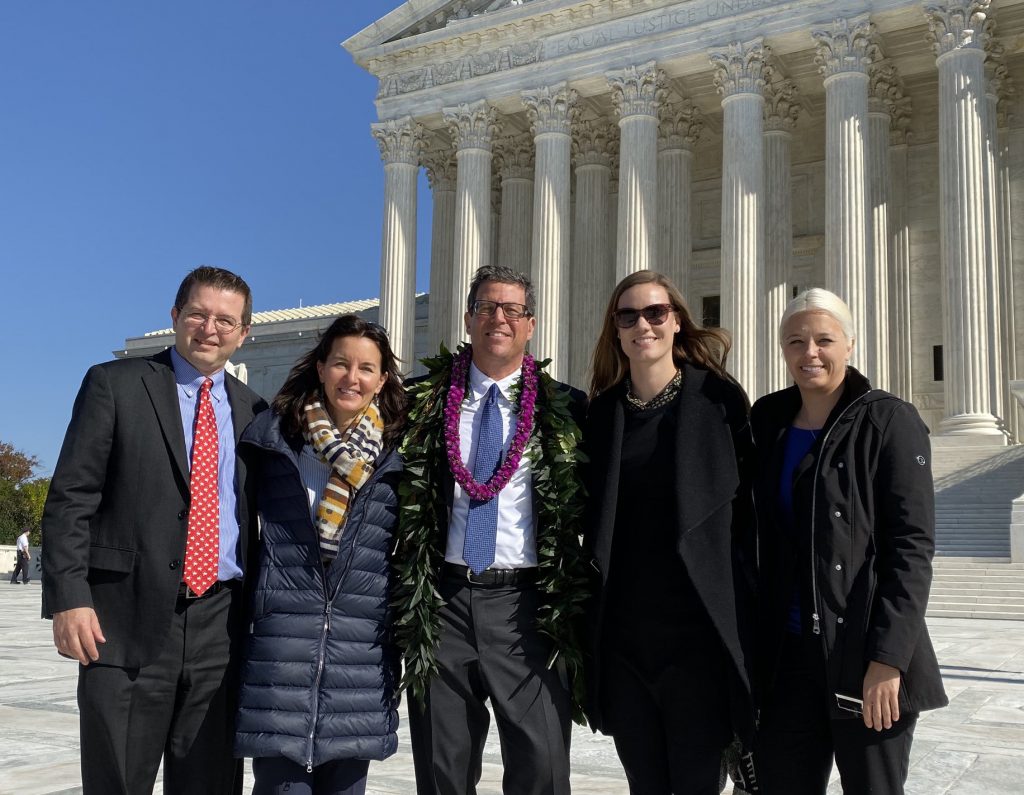Stetson Law plays role in Supreme Court decision on Clean Water Act case

Stetson Law professors and students can stake a claim in a Clean Water Act (CWA) case recently decided by the U.S. Supreme Court that has nationwide implications.
Last summer, Stetson Law’s Institute for Biodiversity Law and Policy filed an amici curiae (“friend of the court”) brief in the U.S. Supreme Court in County of Maui v. Hawaii Wildlife Fund et al. on behalf of aquatic scientists and scientific societies. On April 23, the Court referenced that brief in its 6-3 decision, which held that the CWA covers the functional equivalent of direct discharges of pollutants to navigable waters.
The ruling emphatically rejected the County of Maui and the Trump administration’s attempt to restrict the CWA to direct discharges of pollutants, which would have categorically excluded pollutants conveyed through groundwater, said Royal Gardner, director of the Institute for Biodiversity Law and Policy. It also validated and elevated the importance of science and its role in determining when and how the CWA applies.
“From our perspective, the decision emphasized that science matters,” Gardner said.
Background
The Clean Water Act is a federal law that regulates the discharge of pollutants to the nation’s waters, including lakes, rivers, streams, wetlands and coastal areas. At issue in the Maui case was whether the CWA requires a permit for the discharge of pollutants when the pollutants leave a source and travel through groundwater before reaching navigable waters.
The Lahaina Wastewater Reclamation Facility in Lahaina, Hawaii (Maui County), discharges treated wastewater into the ground with its injection wells, which utilize the earth’s soil as a filter to further clean treated wastewater before it reaches a water source. However, a 2013 study confirmed the pollutants flowed underground from the treatment plant and reached the Pacific Ocean.
Environmentalists sued Maui County and prevailed in the U.S. District Court and Ninth Circuit Court of Appeals. Maui County requested the U.S. Supreme Court to hear and review the case. The county acknowledged the wastewater treatment facility is polluting the Pacific Ocean but argued the CWA covers only discharges directly to a surface water source and not a discharge to a surface water source through a groundwater pathway.
Connecting researchers with decisionmakers
Professor Gardner and Erin Okuno (assistant director of the Institute for Biodiversity Law and Policy) co-authored the brief with a team of attorneys that included Kathleen Gardner (Pollack Solomon Duffy LLP), Christopher Greer (White & Case LLP), and Dr. Steph Tai (University of Wisconsin Law School). The brief sought to explain basic hydrologic concepts, as well as the methods and tools scientists use to track pollutants in groundwater and surface water back to their source. The brief argued that science should inform the courts and agencies’ legal interpretation of when and how the CWA applies to pollutants that reach navigable waters.
Mark Rains, professor and director of the School of Geosciences at the University of South Florida, was one of several scientists who helped write the amici brief. His research is focused on hydrological connectivity and the role that science plays in informing water-related law, policy, and decision-making. He said water laws, in particular, can be challenging to understand because so much of what transpires with water is not visible because it is happening underground.
Rains said he was glad to be part of a team of experts who worked to illuminate that process so that the Supreme Court justices would be armed with the knowledge they would need to make an informed decision in the case. Ultimately, the decision was so well written and nuanced, Rains said, it was clear the justices understood and internalized much of the data in the amici brief.
“I told my students that it was a win for science,” he said.
Real world learning
The entire process—from collaborating on scientific and legal research, to blending scientific and legal writing, and observing the oral arguments before the Supreme Court in the fall—was also a win for students, both at Stetson and the collaborating universities. It created and will continue to provide a wellspring of learning opportunities.
“There’s tremendous value for students to see how the legal system plays out in real life and real time and how their professors play an active role,” Gardner said, adding that he provided updates on the case as part of the regular classroom coursework.
Justice Stephen Breyer’s decision also will provide a good example for legal research and writing classes on the use of text, structure, purpose, and legislative history in statutory interpretation, Gardner noted.
For Rains, he and his graduate students were able to see how traditional scientific prose could be tweaked and blended with legal writing to produce a finished product that was both accurate and effective. There may perhaps have been an even greater professional lesson: many in the scientific community believe they must remain disengaged from civic discourse to maintain the purity of their work. But impartiality and civic engagement don’t have to be mutually exclusive, Rains said. Scientists can contribute to civic discourse by sharing their work and thereby educating decisionmakers on how science can inform their efforts.
Post date: April 25, 2020
Media contact: Kate Bradshaw
[email protected] | 727-430-1580